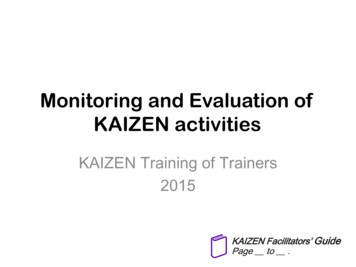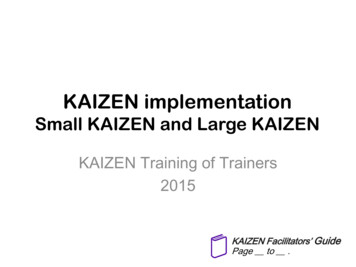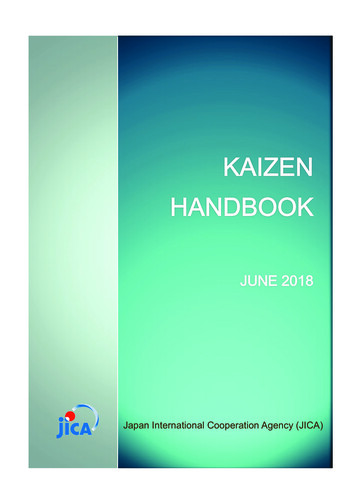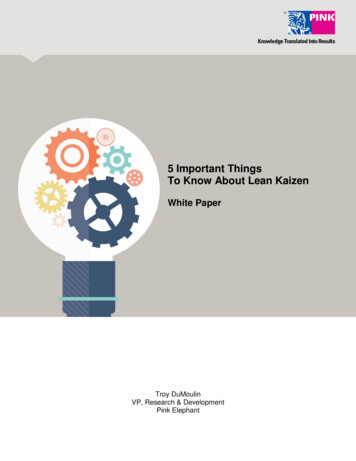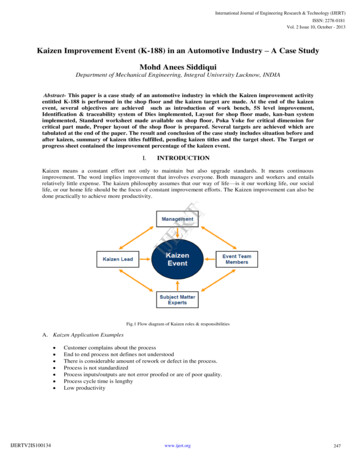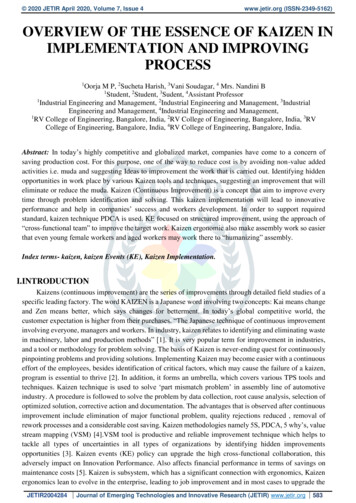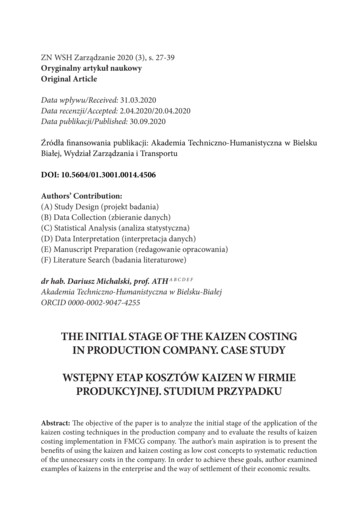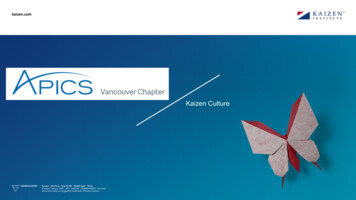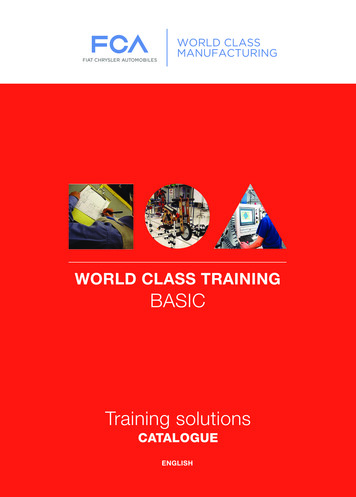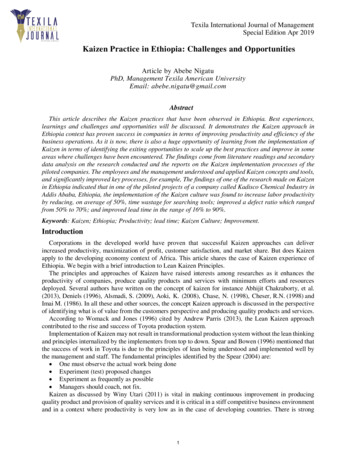
Transcription
Texila International Journal of ManagementSpecial Edition Apr 2019Kaizen Practice in Ethiopia: Challenges and OpportunitiesArticle by Abebe NigatuPhD, Management Texila American UniversityEmail: abebe.nigatu@gmail.comAbstractThis article describes the Kaizen practices that have been observed in Ethiopia. Best experiences,learnings and challenges and opportunities will be discussed. It demonstrates the Kaizen approach inEthiopia context has proven success in companies in terms of improving productivity and efficiency of thebusiness operations. As it is now, there is also a huge opportunity of learning from the implementation ofKaizen in terms of identifying the exiting opportunities to scale up the best practices and improve in someareas where challenges have been encountered. The findings come from literature readings and secondarydata analysis on the research conducted and the reports on the Kaizen implementation processes of thepiloted companies. The employees and the management understood and applied Kaizen concepts and tools,and significantly improved key processes, for example, The findings of one of the research made on Kaizenin Ethiopia indicated that in one of the piloted projects of a company called Kadisco Chemical Industry inAddis Ababa, Ethiopia, the implementation of the Kaizen culture was found to increase labor productivityby reducing, on average of 50%, time wastage for searching tools; improved a defect ratio which rangedfrom 50% to 70%; and improved lead time in the range of 16% to 90%.Keywords: Kaizen; Ethiopia; Productivity; lead time; Kaizen Culture; Improvement.IntroductionCorporations in the developed world have proven that successful Kaizen approaches can deliverincreased productivity, maximization of profit, customer satisfaction, and market share. But does Kaizenapply to the developing economy context of Africa. This article shares the case of Kaizen experience ofEthiopia. We begin with a brief introduction to Lean Kaizen Principles.The principles and approaches of Kaizen have raised interests among researches as it enhances theproductivity of companies, produce quality products and services with minimum efforts and resourcesdeployed. Several authors have written on the concept of kaizen for instance Abhijit Chakraborty, et al.(2013), Deniels (1996), Alsmadi, S. (2009), Aoki, K. (2008), Chase, N. (1998), Cheser, R.N. (1998) andImai M. (1986). In all these and other sources, the concept Kaizen approach is discussed in the perspectiveof identifying what is of value from the customers perspective and producing quality products and services.According to Womack and Jones (1996) cited by Andrew Parris (2013), the Lean Kaizen approachcontributed to the rise and success of Toyota production system.Implementation of Kaizen may not result in transformational production system without the lean thinkingand principles internalized by the implementers from top to down. Spear and Bowen (1996) mentioned thatthe success of work in Toyota is due to the principles of lean being understood and implemented well bythe management and staff. The fundamental principles identified by the Spear (2004) are: One must observe the actual work being done Experiment (test) proposed changes Experiment as frequently as possible Managers should coach, not fix.Kaizen as discussed by Winy Utari (2011) is vital in making continuous improvement in producingquality product and provision of quality services and it is critical in a stiff competitive business environmentand in a context where productivity is very low as in the case of developing countries. There is strong1
DOI: 10.21522/TIJMG.2015.SE.19.01.Art027ISSN: 2520-310Xevidence and background how kaizen helped Japan companies to overcome the productivity and qualitychallenges when the Japanese companies encountered were challenged by the competition from Americanand European manufacturers after mid-1940s (Chen, et al., 2000).In various literatures Kaizen is defined as Japanese ‘Continuous improvement’. Alberto in his workingpaper titled the role of Kaizen in economic transformation he defined kaizen as “Kaizen is a Japanese termto mean ‘improvement ‘and refers to a process of innovation in firms involving the entire work force. Itinvolves customer orientation, quality control, new product development. just in time and automation,cooperative employer – employee relationships and so on.” Alberto E. Lemma (20018).With the success of Kaizen implementation and as it has become culture of wok in Japan. It has becomea strategic approach in Japanese government as a package in the assistance it offers to many developingcountries like Ethiopia and many other African countries through private and public channels ofdevelopment assistance. Izumi and other scholars’ emphasis that there are huge untapped potentials ofimplementing Kaizen in Africa to improve the productivity and inefficiencies challenges African countriessuffer from (Izumi Ohno, et al., 2009).In line with the what we discuss above in terms of the opportunity of getting support from Japanesegovernment through development assistance programs, the introduction of Kaizen in Ethiopia has beenstarted with full assistance of Japanese International Cooperation Agency( JICA) following the requestfrom Ethiopian government for the transfer of Kaizen technology transfer through National GraduateInstitute for Policy Studies( GRIPS) by the time when Ethiopia developed the national Growth andTransformation Plan with the desire of improving the managerial capability and capacity to implement thenational strategy( GRIPS, 2011).The introduction of Kaizen outside Japan through the support from JICA and records of Japan’s successin Kaizen implementation has encouraged other developing countries and in countries where Kaizen hasbeen implemented ,one of these case is Ethiopia, significant changes have been registered in terms ofproducing quality products and improving productivity and has become as the key success factors not onlyfor the success of companies but the countries as well in competing in global markets.The kaizen implementation in some of the Industries in Ethiopia real changes were made and provensignificant saving in resources and improve efficiency (Bethlehem, Herald Changing the way EthiopianIndustries work, June 2018). Ethiopia having a lot of challenges in its endeavor in increased export incomeand in the national strategy of sector shift from agriculture-based economy to industry led economy withthe strategy goal of import substitution the productivity and quality improvement are key for theachievement of the goal. Notwithstanding the challenges, there have been records of encouraging resultsfrom manufacturing companies which implemented the Kaizen initiative in Ethiopia. Looking forward,therefore, would be scaling up the achievements registered in a few companies focusing on the learningsand areas of improvements in the implementation of Kaizen. This article will come up with arecommendation based on the analysis of the practice of Kaizen in the country considering samples ofcompanies which have been implementing the Kaizen culture of doing business.Work culture challenges in ethiopiaThe Japanese work culture and the thinking is more amiable to high productivity and innovation is areason for success in Kaizen implementation. According to George the socio-cultural traits of the Japaneseinfluences the work culture in offices and has been good ground for success in Kaizen culture (Georg O.Tasie, 2009).Culture affects the management styles, decision making processes, the employee responsiveness andperceptions of problems. According to George Japanese have developed their own skills of management,which stem directly from culture and social values and beliefs. The Japanese culture has been influencedby Taoist, Confucian, Asian and Western ideas. Unlike Ethiopians the Japanese are homogenous race, bothlinguistically and culturally and most importantly in relation to the change management Japanese are highlyflexible to embrace change which is key for Kaizen implementation. Ethiopians and Japanese have also2
Texila International Journal of ManagementSpecial Edition Apr 2019similarities in terms of having high power distance, high uncertainty avoidance and being high collectivistunlike the western Culture.The question, therefore, is that the work culture in Ethiopia is it amicable to the Kaizen culture how canthe Kaizen principles and tools be contextualized without costing the standard of the Kaizen approach. So,the challenge is how should a company in Ethiopia implement the Kaizen principles with contextualizationof the approach to the values and norms and at the same time transforming the culture to favorable workenvironment to Kaizen philosophy.As Andrew Parris (2013) indicated in his research “Improving Process for Good in East Africa” WorkCulture in Africa in general and Ethiopia in particular, timeliness is not a priority. Andrew clearly said inhis article that meetings and social events start late. And lateness is acceptable and even expected. Andrewalso cited Mandela saying “South African have no concept of time and this is also why we cannot solvepoverty and social problems (Mandela, 2003).In his research Andrew identified more cultural challenges that the researcher, being an Ethiopian,believes the identified issues are truer to Ethiopian Context than other African countries. The cultural issuesidentified are High level of corruption which required extra reviews and approvals burden processes. People don’t follow written instructions Poor quality is the norm It’s not a problem until it’s a problem Life is unpredictable Workers are not expected to innovateThe findings of the research by Andrew informs that the Kaizen implementation in Ethiopia will havechallenges related to culture change. To make decisions faster and to remove the none value addingprocesses steps, it clearly requires culture change; the way how people do their work and the mindset shiftfrom ‘it is okay ‘to ‘we need to change ‘thinking. Other researches like Eden M. (2017) and Tigist, H. (2015)in their thesis for their Master’s degree also confirmed the same culture related issues are bottlenecks of theKaizen implementation in companies which piloted the implementation. Many researches affirm thatculture change is critical factor in successful implementation of Kaizen when transferred to other cultures.Anh et al (2011) emphasized the fact that the success of Kaizen culture transfer is highly dependent on theculture context of a given country where Kaizen is implemented.Kaizen implementation practice in ethiopia and results achievedKaizen as a management tool was introduced in Ethiopia in 2009 with JICA in response to the requestfrom the government of Ethiopia to Japan government as part of the development cooperation the twocountries have had for many years. The government of Ethiopia was keen to implement the Kaizenphilosophy to enhance the national development strategy to foster economic growth through improvingproductivity and efficiency.The Government of Japan through JICA agreed to offer assistance in transferring the Kaizen technologyand the Kaizen project was designed with the close support from JICA. As indicated in GRIPS report (2011)cited by Admasu (2015), after the project design phase was completed, the former Ministry of Trade andIndustry established kaizen unit with professionals drawn from the ministry and relevant sectorialinstitutes, and JICA deployed a consultant team to work with the Unit. The kaizen project was officiallylaunched with the first National Kaizen Seminar in the presence of high-level officials from both sides.With the project pilot companies, kaizen is selected as one of management tools to improve and enhancemanagerial capability to implement Growth and Transformation Plan (GRIPS, 2011).According to Shimada, the director of Research Program Division of JICA Research Institute, the projectwas designed jointly by JICA and Ministry of Industry (Ethiopia) with a project life from October 2009 to2011. The sector focused for the piloting phase was manufacturing sector of 28 companies selected. Theproject was designed with three objectives:3
DOI: 10.21522/TIJMG.2015.SE.19.01.Art027ISSN: 2520-310X Polite project performance to scale it up to national levelHuman Resources Development aiming to transfer Kaizen skills to staff of ministry of industry(Ethiopia) National Plan Formulation- to disseminate the Kaizen activates across the manufacturing companiesin Ethiopia.As can be seen in the diagram below Ethiopian is one of African countries which are implementingKaizen in Africa since 2009.Source: JICA research program divisionAs reports from JICA Research Institute presented by the director to audience gathered for a workshopon Kaizen summarizes the results achieved from the piloted projects.Qualitative results achieved: Clean working environment created,Team work and motivation of workers developed,Health and occupational safety of workers improved,Lower level workers accustomed to suggesting improvementideas to management decisions – Increased EmployeeParticipation,Knowledge obtained on how to meet quick delivery and to reduce costs.Quantitative results Monetary impact from the improvements reported is ETB 500,000/company.The reporting ranges from ETB 10,000 to ETB 3.2 mill.By Reducing costs (a) ETB 10,000 per month and (b) ETB 78, 000 perannum;By generating additional income of ETB 1.2 million per year;By just decreasing down time ETB 204, 000 per day,By rectifying raw materials defect used for manufacturing ETB 2.4mill;By identifying, repairing and reusing of usable machines & equipmentworth of ETB 3.25 mill.Non-monetary measures of improvement include Increasing labor productivity, by reducing time loss for searching tools onaverage 50%;Reduction of floor space around 50%;Defect ratio improvement in the range of 50-70%;4
Texila International Journal of ManagementSpecial Edition Apr 2019 Lead time improved in the range of 16 to 90%; Labor saved from 15 to 90%.Note: Note: USD1 approximately ETB 17.1 as of Aug. 2011Source: JICA research departmentAfter the project completion it was found that out of 28 companies piloted 10 (more than one- third)were graded with excellent achievements which can be considered as success to have Kaizen Modelcompanies. This result encouraged the government of Ethiopia and JICA to scale up the Kaizenimplementation in other companies as well. After the piloting phase, several companies implemented thekaizen philosophy across the country mainly in manufacturing factories.Analysis of researches/ studies made on companies which implemented kaizen cultureThis analysis was made on researches available on the practice of Kaizen implementing companies inEthiopia. Three studies were consulted for the analysis.The study made by Tigist Hailegiorgis for fulfillment of her Master’s Degree “Assessing of theEffectiveness of Kaizen Implementation in Wonji sugar Factory”.This study was made in one of the oldest sugar factories in Ethiopia. The finding was stated as“The Kaizen implementation was recorded as success in terms of minimization of waste and, as a resultproduction cost reduction, increasing efficiency, creation of good relationship between employees andmanagement, increasing employees’ attitude towards teamwork, facilitation of the factory's conduciveworking environment and improving work commitment. “(Tigist, 2015)Woni Sugar factory being one of the oldest factories in terms of time of establishment, it is encouragingthat Kaizen tools applied in the processes of the factory resulted in increased efficiency. From the result ofthe study one can see that Kaizen philosophy is getting into the thinking of the employees and themanagement. The Kaizen tools changes the work culture but not easy as indicated by Tigist in her study5
DOI: 10.21522/TIJMG.2015.SE.19.01.Art027ISSN: 2520-310Xindicated that sustaining the changes achieved is critical. Sustainability can be ensured only when themindsets and the culture change embrace continuous improvement. Kaizen philosophy is all aboutcontinuous improvement and implementers should not be contented with the results achieved in a givenperiod of time. It should be continuous and better in the future. Tigist suggests that to sustain the changethe factory should apply different motivation scheme to employees so as to enhance engagement ofemployees for more change and better. Tigist’s recommendation is in agreement with the opinion of anotherresearcher Asayehgn Desta.“Implementation of kaizen in manufacturing companies needs to be fully committed to boosting themorale of their workers to develop members’ capabilities, to achieve self-actualization, and to workcooperatively, these commitments are vital to the process for improving the quality of the training output.”Asayehgn Desta (2011)The study made by Eden Mekonnen for her Master’s Thesis with the topic “Assessment of KaizenImplementation Practices and Challenges in the case of Tikur Abbay Shoe Share Company “(Eden M.,2017) shows the results of the Kaizen implementation in this shoe manufacturing company has not shownmuch successes. The challenge indicated by Eden is that the management and employees seem to lackclarity on the engagement level of employees in the change process (Eden m., 2017). This study raises someconcern as the study was very recent and the results contradict the good achievements during the pilotingphase seven years back. It is important that further research is made on the status of Kaizen implementationin Ethiopia in terms of how sustained the results have been in several other companies after significantperiod of time for the Kaizen philosophy expected to be rolled out across the country and integrated wellin the traditions and culture of Ethiopian companies. Some findings like these ones, after seven years, createcuriosity to scholars and invite research on the practice of the Kaizen tools.Eden has also mentioned in her study that conceptual misunderstanding between middle level managersand front-line employees on Kaizen was observed. The employees are not buying in the new culture ofKaizen either due to lack of proper communication or training.Eden explains her observation obtained through interview of employees and the Kaizen officer as:“there are still conceptual gaps on the knowledge of continuous improvement and have the impressionof the traditional hierarchical work trends and these trends are still challenges for change. The situationcould also have implications on quality of products and services and it has also depressing effect on thegenerating and sustaining improvements.”When there exists a gap in understanding of the Kaizen philosophy and the tools the impact expected ofKaizen on quality production of products and services will be adversely affected and may even causenegative impact on the sustainability of the Kaizen continuous improvement approach. This study, therefore,indicates that Kaizen implementation has not been success in a few of the companies which have undergoneimplementation.The success depends on planning for rolling out of the tools and the commitment of leadership to engageall employees from top to bottom. In countries where organizational culture is more hierarchal and more ofrigidity in managerial practice, kaizen implementation needs more effort culture change before launchingof any project. As Kaizen is a continuous process improvement philosophy, the transferability of the kaizenculture is dependent on the level of engagement of employees and the decision-making process. Themanagerial decisions should be employee driven and the synergy between the kaizen culture and theorganizational culture is key for the success of effective and sustainable transfer of Kaizen technology.A study conducted by Nesra Seid ( 2012) in one of a chemical industry called Kadisco indicated that theproductivity of a company was significantly improved as a result of improvements made on time wastagewhich is registered to be reduced by average of 50% and defected ratio improvement on average from 50%to 70% and lead time on average from 16% to 90% which proves that the kaizen culture has brought changeswhich can be scaled up in other manufacturing. Asayhegen desta et.al (2014) also conducted a study onthree companies (Mesfin Industrial Engineering PLC, Almeda Textile Factory PLC., and Sheba Leatherand Tanning Industry PLC), among selected for piloted project during phase I of the Kaizen implementation6
Texila International Journal of ManagementSpecial Edition Apr 2019he indicated in his finding that the transferability of the culture was challenged by the existingorganizational culture that the results were not successful. From this study and others, we can see thatKaizen Culture success depends largely on the change in the culture. As some studies indicate a certainlevel of improvements in productivity and efficiency can be achieved but the sustainability dependscritically alignment of the organizational culture to the Kaizen culture. When there is lack of synergybetween the Kaizen culture and the existing culture of an organization, sustainability can be guaranteed.Most organizations which failed in Kaizen implementation simply due to the lack of cultural transformation.In Ethiopia it has been about 10 years since Kaizen was introduced. It is, therefore, attractive for scholarsto do research to know if Kaizen has been successful or to identify challenge and opportunities in Kaizenimplementation in Ethiopia.Unique challenges to kaizen implementation in ethiopiaDue to continuing economic, environmental, cultural, and political difficulties, life in Ethiopia continuesto be difficult and somewhat unpredictable. Despite all the political and global economic challengesEthiopia has registered a double-digit economy growth for the last ten years. Recently a political reformhas been taking place which introduced economic reforms through opening up the market and moreprivatization.Despite the government effort to change the economic structure one of the challenges for Ethiopia hasbeen competitiveness in the global market. According to Getinet and Admit Ethiopian experience inindustrialization and competitiveness was found to be poor (Getinet and Admit, 2005). Competitiveness iskey in sustaining the development efforts in the globalized world. Competitiveness is a must to face it andcan only overcome challenges and grasp the opportunities provided by globalization when only when aneconomy is competitive in the world market. This is more appealing to the countries like Ethiopia whichaspire to have export led economy.For a growing economy like Ethiopia low productivity has always been an impasse to be competitive inthe global market. The extent of productivity improvement counts more to competitiveness than otherproduction factors. Most of growing manufacturing factories both private and public in Ethiopia suffer fromthe inefficiency of production mainly due to poor processes. To improve efficiency and productivity,therefore, Kaizen tools would be appropriate to the Ethiopian manufacturing and services sectors. Severalcases studies conducted in the companies which implemented Kaizen show that productivity and efficiencyis significantly being improved.The critical challenge for manufacturing sectors in Ethiopia and like most other developing economiesis the lack of managerial methodologies like Kaizen (Izumi Ohno, et al.,2009). It is true that lack of capitaland technological capabilities are major problems in the manufacturing and service sectors, the mostfeasible and that can be easy and quick to be improved with a little investment and resources is changingthe managerial capacity with Kaizen tools Kaizen (Admasu A., 2015). This is why Kaizen becomes anappropriate tool for developing economies.Andrew Parris discussed in his study on the challenges of process improvement in East Africa that withlow level of economy , the scarcity of capital and resources to cover budget required for investment ininnovation and technological improvement becomes a challenge to a country and may lead to fragility,outdated, inefficient and ineffective infrastructure, equipment/tools and processes( Andrew P.,2013).In a context where capital scarcity is high, when processes are not efficient and effective and whenproductivity is low, the need for Kaizen culture becomes more evidently appealing. The drive forcontinuous improvement with a kaizen methodology is due to the low investment the Kaizen tools requires.Kaizen does not take huge investment and expertise. It only takes available resources, commitment,engagement and mindset to change the way business is done, i.e. culture change.The culture aspect also is major challenge in the implementation of Kaizen. The cultural factors have ledto inflexible, bureaucratic process with too many hand- offs, reviews, and approvals have been challenges7
DOI: 10.21522/TIJMG.2015.SE.19.01.Art027ISSN: 2520-310Xto Kaizen implementation. When the processes are not well integrated as a result of the culture result inpoor quality products and services and long lead time in process.In addition to these unique challenges, we note some trends affecting developing countries. Some of thechallenges below were discussed by Andrew Parris in his research on what international NGOs are facingin their work in his article on “Improving Processes for good in East Africa” (Andrew P.,2003). Theresearcher believes and is convinced that some of the issues discussed in this article are also true for businesscompanies operating in Ethiopia. Some of the issues are found to be more relevant to Ethiopian context andborrowed from the findings of Andrew.The contexts in which companies particularly the manufacturing companies work are gettingincreasingly dynamic and complex. To respond to this dynamics processes and decision-making approachesneed to be improved to respond effectively to sustain the business both in local and global markets inincreasingly competitive market environment.International development partners are demanding greater impact, transparency, and accountability inthe development endeavors with efficiency given a priority demand. Competition to expand market sharedemands responsiveness, high quality and customer values in all aspects of the business dimensions.Global market is being affected by the policies that a few developed countries are making. For instance,the tariff/taxes and protection police introduced by US and China currently is big challenge for developingeconomies. On top of the challenges the poor countries already have, the new trend of global businesscompetition is creating difficult situation. Developing nations have been striving to make long-terminvestments in micro and macro projects to get out of poverty and the opportunities to get loans andtechnology transfer through foreign direct investment is facing new era of challenge. More than ever,countries must find new, innovate ways to use available resources in most efficient and effective way.Kaizen can be the best-chosen tool to do business in innovative ways.Technological and communications advances are significantly disrupting legacy approaches to manycompanies in terms of organizational effectiveness these advances require rapid and agile adaptation andinnovation of companies and their employees.Developing nations like Ethiopia are generally urbanizing faster and growing faster economically thandeveloped nations. This requires companies s to change where and how they work, and how they providevalue to the people they serve. This is why Kaizen is highly recommended to be practiced in Ethiopia.These trends oblige companies to more quickly experiment, learn from experience, adopt new ways ofdoing things, and adapt themselves to their changing contexts (Andrew P., pp 2013). This justifies whyKaizen needs to be promoted in Ethiopia. Ethiopian Companies, we believe, have to quickly learn and adaptchanges happening in the business environment. Researches indicate that those companies in Ethiopiawhich implemented Kaizen have significantly managed the changing business environment.Why lean kaizen is vital for ethiopiaThe business environment globally is becoming more competitive and challenging in general and fordeveloping economies in particular. Several studies on development of Ethiopia show that low productivityand poor quality both in production and service is the bottleneck for the economy. Birhanu Beshah (2013)in his presentation on “The need for Quality and Productivity Improvement “cited Daniel Kitaw and et alindicated that the competitiveness of the manufacturing industries is low and the quality managementawareness is low.According to the studies Brihanu mentioned in his presentation the quality problems are observed inseveral sectors in Ethiopia economy. In education, health, public services and construction industriesquality has been recorded at low. The quality thinking is not reflected in the work culture and poor-qualityproduct and services continues to constrain the economic development.Ethiopian companies have been struggling to survive in the global market mainly due to quality factor in thecompetition world. When competition increases, developing economy is prone to failure. The need forcontinuous process improvement becomes essential for such economies. Increasing competition in global8
Texila International Journal of ManagementSpecial Edition Apr 2019economy necessities Kaizen philosophy, continuous improvement, to be implemented in developingeconomies like Ethiopia. Quality of products and services improvement is required by the competition in theindustrial world (Winy Utari, 2011).There is huge opportunity to effectively transfer Kaizen technology to
Kaizen implementation in companies which piloted the implementation. Many researches affirm that culture change is critical factor in successful implementation of Kaizen when transferred to other cultures. Anh et al (2011) emphasized the fact that the success of Kaizen
